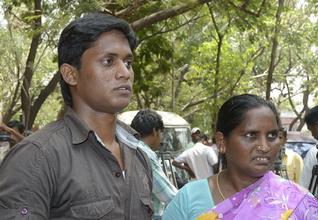 Chennai, Jul 4: A dalit boy, whose marriage to a Vanniyar girl triggered anti-dalit violence in three villages of Tamil Nadu's Dharmapuri district in November last year, was found dead along a railway track in that town on Thursday, a day after his wife said she would never go back to him and would stay with her mother.
Chennai, Jul 4: A dalit boy, whose marriage to a Vanniyar girl triggered anti-dalit violence in three villages of Tamil Nadu's Dharmapuri district in November last year, was found dead along a railway track in that town on Thursday, a day after his wife said she would never go back to him and would stay with her mother.
Railway police said Ilavarasan was found along a track behind the government arts college in Dharmapuri.
News of the boy's death led to a tense situation in dalit areas in Naickenkottai, with many of them thronging the Government Medical College hospital, where his body was taken.
Dharmapuri superintendent of police Asra Garg said raliway police are conducting an inquiry and that it was too early to say if there any foul play. Police pickets have been posted in sensitive areas in Naickenkottai.
The girl Divya told reporters on Wednesday after appearing for a hearing in Madras high court that she has been under tremendous pressure all along and was unable to forget her father who committed suicide after her marriage. She also said she no longer wanted to live with her husband, but her mother.
The bench comprising Justice M Jayachandran and Justice M Sunderesh had reserved the orders for Friday.
Her mother had filed a habeas corpus petition to produce her before the Court and set her at liberty.
On July 1, Divya had told the court she would go with her mother "for the time being". She also said she had no problems in the house of her husband or with her mother-in-law, but was haunted by incidents of her father's death, who committed suicide after her marriage with Ilavarasan of Natham village.
Divya's mother too had opposed the marriage on October 14. Three villages of Dharmapuri district — Natham, Kondamapatty and Annanagar — witnessed violence and about 296 huts belonging to dalits were torched on November 7 after the girl's father committed suicide.
Several writ petitions were filed and the court ordered a probe into rehabilitation measures taken in dalit colonies under the committee headed by IAS officer Vaski, which submitted a 5000-page report to the high court.





Comments
Add new comment